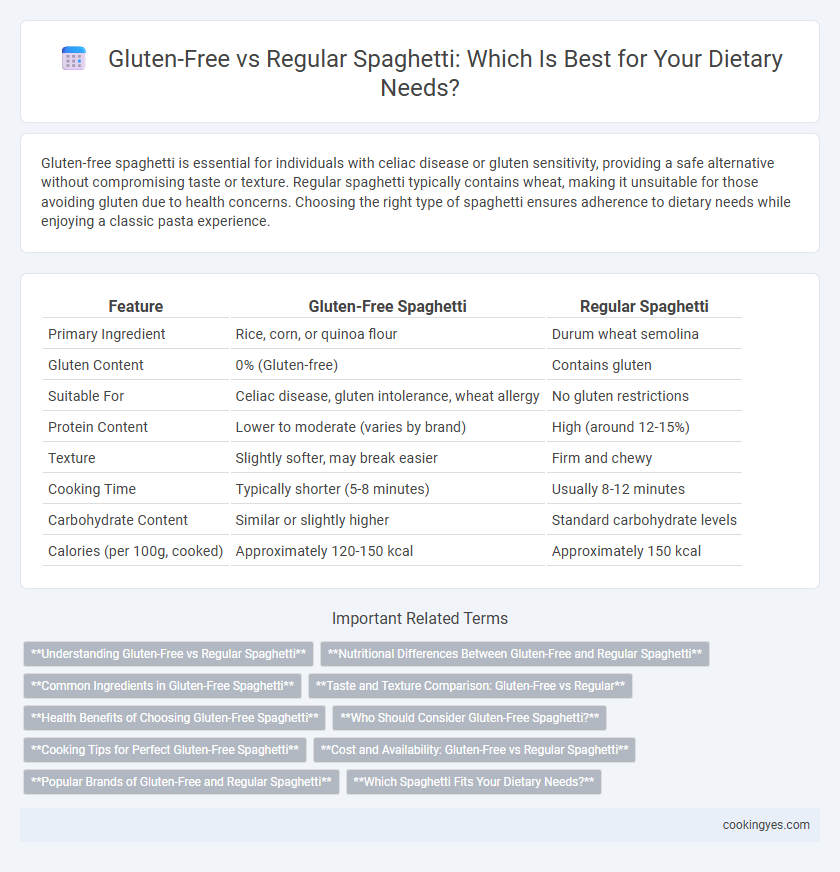Gluten-free spaghetti is essential for individuals with celiac disease or gluten sensitivity, providing a safe alternative without compromising taste or texture. Regular spaghetti typically contains wheat, making it unsuitable for those avoiding gluten due to health concerns. Choosing the right type of spaghetti ensures adherence to dietary needs while enjoying a classic pasta experience.
Table of Comparison
| Feature | Gluten-Free Spaghetti | Regular Spaghetti |
|---|---|---|
| Primary Ingredient | Rice, corn, or quinoa flour | Durum wheat semolina |
| Gluten Content | 0% (Gluten-free) | Contains gluten |
| Suitable For | Celiac disease, gluten intolerance, wheat allergy | No gluten restrictions |
| Protein Content | Lower to moderate (varies by brand) | High (around 12-15%) |
| Texture | Slightly softer, may break easier | Firm and chewy |
| Cooking Time | Typically shorter (5-8 minutes) | Usually 8-12 minutes |
| Carbohydrate Content | Similar or slightly higher | Standard carbohydrate levels |
| Calories (per 100g, cooked) | Approximately 120-150 kcal | Approximately 150 kcal |
Understanding Gluten-Free vs Regular Spaghetti
Gluten-free spaghetti is made from alternative grains such as rice, corn, or quinoa, catering to individuals with celiac disease or gluten sensitivity by eliminating gluten proteins found in wheat-based regular spaghetti. Regular spaghetti contains gluten, which provides elasticity and texture but can cause adverse reactions in those with gluten intolerance. Choosing between gluten-free and regular spaghetti depends on dietary restrictions, digestive health, and nutritional preferences, with gluten-free options often fortified to match the nutritional value of traditional wheat pasta.
Nutritional Differences Between Gluten-Free and Regular Spaghetti
Gluten-free spaghetti is typically made from alternative grains like rice, corn, or quinoa, resulting in a higher fiber and protein content compared to regular wheat-based spaghetti. Regular spaghetti contains gluten, providing specific texture and elasticity, and generally offers more carbohydrates and fewer calories per serving than gluten-free options. Individuals with celiac disease or gluten sensitivity must choose gluten-free spaghetti to avoid adverse reactions, while those without restrictions can consider nutritional differences based on fiber, protein, and glycemic index.
Common Ingredients in Gluten-Free Spaghetti
Gluten-free spaghetti typically contains ingredients such as rice flour, corn flour, quinoa, and tapioca starch, which cater to individuals with celiac disease or gluten intolerance. These alternative flours provide a similar texture to regular wheat-based spaghetti while avoiding gluten proteins that trigger adverse reactions. Understanding these common ingredients helps consumers make informed dietary choices without compromising on taste or nutritional value.
Taste and Texture Comparison: Gluten-Free vs Regular
Gluten-free spaghetti typically offers a different taste and texture profile compared to regular wheat-based pasta, often being denser and sometimes slightly grainy due to alternative flours like rice, corn, or quinoa. Regular spaghetti provides a familiar chewy texture and richer flavor, attributed to gluten's elasticity and wheat's natural starches. Individuals with celiac disease or gluten sensitivity benefit nutritionally from gluten-free options, while those prioritizing traditional texture and taste may prefer regular spaghetti.
Health Benefits of Choosing Gluten-Free Spaghetti
Gluten-free spaghetti offers significant health benefits for individuals with celiac disease or gluten sensitivity by preventing digestive discomfort and promoting gut health. Made from alternative grains like rice, corn, or quinoa, it provides essential nutrients while eliminating the inflammatory effects of gluten. Choosing gluten-free spaghetti supports better nutrient absorption and reduces risks associated with autoimmune reactions linked to gluten consumption.
Who Should Consider Gluten-Free Spaghetti?
Individuals with celiac disease or non-celiac gluten sensitivity should consider gluten-free spaghetti to avoid adverse reactions caused by gluten proteins found in traditional wheat-based pasta. Those with autoimmune conditions or digestive disorders benefit from gluten-free options, which can reduce inflammation and gastrointestinal discomfort. Athletes or health-conscious consumers seeking alternative grains like rice, corn, or quinoa may also prefer gluten-free spaghetti for improved nutrient diversity and digestive health.
Cooking Tips for Perfect Gluten-Free Spaghetti
Cooking gluten-free spaghetti requires careful attention to water temperature and stirring to prevent clumping and uneven texture. Use plenty of boiling water and salt it generously to enhance flavor, then rinse the cooked pasta with cold water to stop further cooking and reduce stickiness. For the best results, cook gluten-free spaghetti slightly less than the package recommends and let it finish cooking in the sauce to absorb flavors and achieve the perfect al dente bite.
Cost and Availability: Gluten-Free vs Regular Spaghetti
Gluten-free spaghetti typically costs two to three times more than regular pasta due to specialized ingredients and production processes, making it less budget-friendly for many consumers. Availability of gluten-free options is increasing in supermarkets and online retailers but remains limited compared to the widespread presence of regular spaghetti, which is stocked in nearly all grocery stores worldwide. Consumers seeking gluten-free pasta often need to shop at health food stores or specialty sections, impacting convenience and overall access.
Popular Brands of Gluten-Free and Regular Spaghetti
Popular gluten-free spaghetti brands such as Barilla Gluten-Free, Tinkyada, and Jovial offer options made from rice, corn, or brown rice flour, catering to celiac disease and gluten sensitivity. Regular spaghetti from well-known brands like Barilla, De Cecco, and Ronzoni provides traditional wheat-based pasta rich in gluten, favored for its texture and taste. Consumers must evaluate dietary restrictions and product ingredients when choosing between gluten-free and regular spaghetti to ensure nutritional needs and preferences are met.
Which Spaghetti Fits Your Dietary Needs?
Gluten-free spaghetti, made from rice, corn, or quinoa, suits individuals with celiac disease or gluten sensitivity by preventing adverse reactions and promoting digestive health. Regular spaghetti, typically durum wheat-based, provides higher protein and fiber content beneficial for those without gluten restrictions. Choosing the right spaghetti depends on dietary needs, balancing nutritional benefits and gluten tolerance.
Gluten-free vs Regular spaghetti for dietary needs Infographic

 cookingyes.com
cookingyes.com